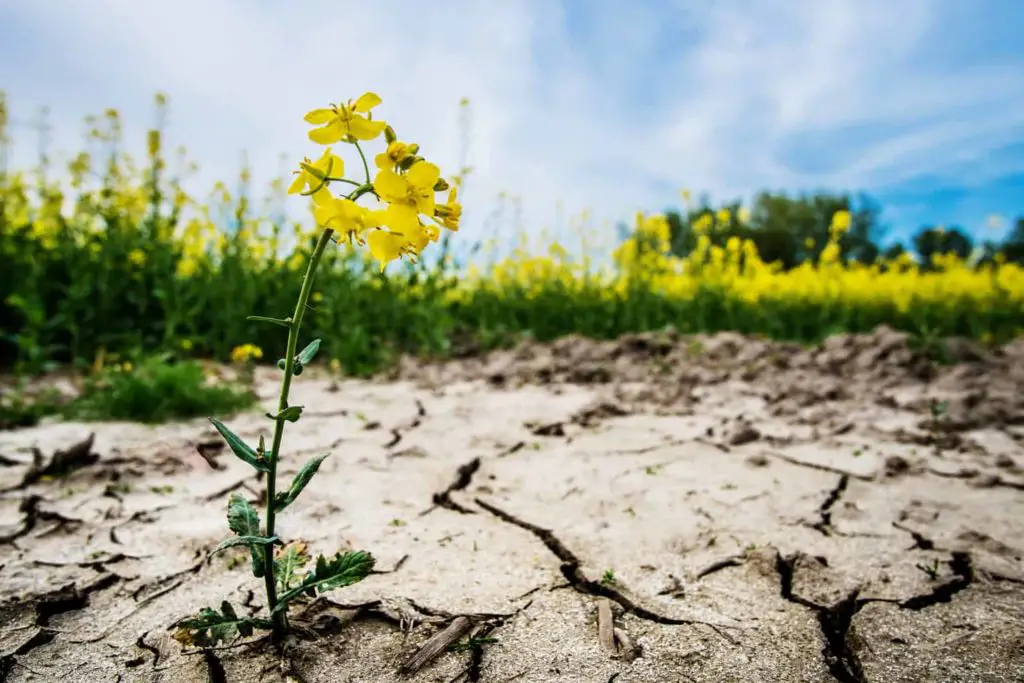Heatwaves, just like other inconvenient weather conditions are uncontrollable and in many places unavoidable. The only thing we can do about it is look at implementing as many ways as possible to protect our plants from these harsh conditions.
In this article you will learn all there is to know about caring for plants in a heatwave. You will be able to identify the signs of a sun-damaged plant and know what to do to revive it. Not only that, but we will also be covering what you can do to prepare your garden for a heatwave so that when it does happen, your plants won’t get too upset about it.

What Happens When Your Plants Get Too Much Sun
It is a common misconception that plants get sunburnt. Plants need sunlight in order to photosynthesize and therefore have their own natural ways of protecting themselves from sunburn. What does happen however is that a plant can get damaged from too much sun exposure?
Plant Sun Damage Signs to Look Out For
The first thing you will notice is the leaves starting to discolor. This might be as subtle as a little bit of lighter green patches, too obvious yellow or white patches. More often than not these will be the only telltale signs that show you your plant has been damaged, although there are a lot of other areas that are damaged too.
You might be surprised by the way your greenhouse plants react when moved to your garden and are in direct sunlight. Plants that have always grown in your garden have gotten used to protecting themselves in direct sunlight. Plants that have been grown in greenhouses and then been moved to a garden suffer tremendously.
Greenhouse plants are constantly subjected to bright lights, but these lights are filtered through the glass, meaning the harmful UV rays do not reach them. As soon as an established greenhouse plant is moved into the garden, it is less able to protect itself from direct sunlight than other plants in your garden.
How to Protect Plants During a Heatwave

As soon as you notice your plant is damaged, you must shade it for longer periods of time in the day. Here is a step by step guide to reviving your plant:
- Trim any damaged leaves if possible. Unfortunately, these leaves will not repair themselves, the plant will regrow healthy leaves when it is ready.
- Place a shading umbrella over the damaged plant.
- Allow it only a few hours of sunlight per day. This must not be during the hottest times of the day as the sun will still be too strong for it.
- Once you see the plant is improving slightly, increase the number of hours it is in the sunlight slowly.
Stay patient and follow these steps for as long as your plant needs a little bit of a break from the harsh sun. You can put your plant back into the garden, or remove the sunshade from it once you notice it has fully recovered and is a vibrant shade of green again.
Hardening Off Your Garden Plants
For those of you that have never heard of the phrase ‘hardening off’, it means to prepare your new plants for life in your luscious, hot garden. This is usually done to plants that have been homegrown from seeds or have been bought from a greenhouse when they are just tiny little stumps.
Instead of shocking plants and moving them straight from a cozy controlled environment, to the harsh realities of outdoor life, this technique gets them ready without being damaged in the process. You don’t need to have a large greenhouse to do this either. Plants that are grown and cared for in your home can be transitioned into your garden too.
Here is our step by step guide to hardening off your plants:
- Put your little plants or seeds into a pot or box that is easy to carry around. You will be moving the plants around quite a bit during this process.
- Put the plants in a shaded area of the garden for a while during daylight hours. This gets them used to not only natural sunlight and heat but also winds and other environmental factors.
- Increase the number of hours the plants are outside in the shade gradually until the plants reach a stage where they are outside for a whole day.
- Next, move the box of seeds or plants into a sunny area of the garden, one that is not shaded at all by umbrellas or other plants.
- Leave the plants in the sun for a few hours per day, gradually increasing the number of hours in direct sunlight.
- Once the plants have reached the point that they are out in the sun for a whole day, they are ready to be introduced to your garden as permanent garden plants.
This can be done in preparation for a hot summer that is yet to come. You can also remove any plants that are struggling in the heatwave from the garden temporarily and ‘harden’ them off that way.
What Happens When Your Soil Gets Too Much Sun?
It isn’t just your plants that need extra protection during heat waves. Garden soil can dry out and become almost infertile in a matter of days when not cared for properly.
Understanding what type of soil you have is very important. If you are planning on planting in pots, then you have much more control over the soil as you can purchase the right type of soil for the plant.
When planting in your garden, you will be planting in the soil that is already present. Not all soils are good for all plants, this becomes especially important in extreme weather such as heatwaves.
Choosing the right plants for the soil is a good way of protecting your plants in a heatwave. Here are a few checks you can do on your soil to understand its natural compounds better and will help you choose the right plants.
Light Soil
Light soil is made of gravel, sand, or stones. This is probably the most difficult soil to care for, especially during heatwaves. Light soil isn’t rich in minerals, nor does it hold much water. You should mix in a high-quality fertilizer with this soil before planting, and maintain it with heavy mulch.
Heavy Soil
Heavy soil is sloppy looking in the winter and dense and dry in the summer. When this soil is watered properly it is very rich and holds moisture quite well. However, in the summer, the soil is hard to dig and cracks easily, suffocating the plants rooted in it. This soil should be churned during heat waves and mixed with other soil substances to make it lighter.
Now that we know how to prepare the soil during a heatwave, let’s look at the steps we take for preparation:
- Water the soil regularly, even if there isn’t a plant growing in the soil just yet.
- Shade the area as much as possible to stop the soil from drying out.
- Mix the soil with fertilizer if it is sandy and dry
- Pack mulch on top of the soil to protect it from the heat and sunlight.
Planting New Plants Near Tall Plants
Sometimes the solutions to a problem are easier than we think. If you have plants that you have been waiting for the hotter weather to plant, then placing them around the garden strategically will be beneficial.
Planting new or smaller plants near tall plants will provide shelter from wind and rain during the winter. Most importantly though, tall plants shade smaller plants significantly during heat waves. More shade means lower temperatures, just what the new plants need during a heatwave.
Shade Cloths and Umbrellas for Plants During Heatwaves

Shade cloths and shade umbrellas are cost-effective ways to protect your garden. Better yet, they are not permanent and can be removed and stored away during the colder seasons.
The Best Umbrellas to Use During a Heat Wave
You won’t want a completely opaque umbrella for your plants as they do need a lot of sunlight to survive. The best umbrellas are ones that allow about 50% sunlight through. You can choose when to open and close them depending on the plant’s daily sunlight needs.
The Best Shade Cloths to Use During a Heat Wave
Shade cloths come in different shade percentages. Shade cloths can’t be removed as and when and will probably be permanent garden fixtures until the end of the summer. Here is our step by step shade cloth guide:
- Assess the area you want to shade, how much sunlight do the plants need every day? You may need to do a little research, or ask your local garden center. Vegetables, for example, will only need a cloth that blocks out 30% of the light as they need many hours of sunlight to grow.
- Do you want to create a shade wall or a shaded roof? Decide how you want to shade the plants before proceeding to take measurements.
- Always add a few extra inches to the measurements you take to allow for any errors.
- Either make the shade cover or wall yourself or bring in an expert.
Mulch Protects Plants in a Heatwave
In a heatwave, natural, moist mulch is your best friend. You will want to pack it tightly on the soil that has not yet been planted in, as well as in between plant stems. This will help pack moisture into the soil and prevent water from evaporating out of the soil during hot hours of the day.
If you are using your own homemade mulch, be very careful as it can contain lots of weed seeds that will be triggered to grow in the sunlight. To avoid unwanted weeds, treat the mulch against weeds before using it.
Avoid light-reflective artificial mulch as it will increase the amount of heat and light that the plant is exposed to. This will cause rapid sun damage that may be beyond repair in a heatwave.
Best Time to Water Plants in a Heatwave

Your plants should be watered about three times per day during a heatwave unless you have a way of providing them with a constant trickle of water. Water them once in the early hours in the morning, again at about 3:00 or 4:00 in the afternoon and finally late in the evening.
Watering the plants in the middle of the day will only result in the water evaporating away and the plants not drinking enough. Overwatering your plants is just as dangerous as underwatering, finding the balance is key here.
Make a watering plan for your plants. Some will need more water than others and the best way to keep on top of it is by having a checklist.
Planting New Plants in a Heat Wave
It is always best practice to plant any new seeds at the beginning of spring when the temperatures are milder and a little more manageable, however, not all of us can do that. Some of us live in climates that are hot all year round and don’t get enough cool months to do all of our plantings.
The trouble with a heatwave is that you never know when it will end, it could be in a matter of days or last until the end of summer. Just because we have so many uncontrollable factors involved in gardening, doesn’t mean we have to scrap the whole idea if we are experiencing a heatwave.
New seeds and transplants are especially fragile, let alone when being subjected to extreme weather. If you have seeds that you want to plant but are unsure if they will survive the heatwave, there are a few things you can do to ensure they make it.
- Only plant the seeds in hydrated soil.
Prepare the soil well before planting a seed, this is applicable for any time of the year. You must water the soil regularly for about a week or so before planting. This will ensure the soil isn’t dry and dense. Don’t forget to plant the seed in very fertile soil, using fertilizers in the preparation will help the seed in its first few weeks in the soil.
- Think about positioning.
Where are the seeds being planted? Have they got established, tall plants growing next to them? Planting new seeds in an open space with no tall neighbors may be detrimental to the new seeds. Seeds need plenty of shade and water to grow healthy roots.
- Plant the seed deeper.
Plant new seeds about an inch or two deeper into the soil than you normally would. Doing so will stop the seeds from overheating or being damaged in any way. Do any long gardening work in the early morning or late in the evening during heat waves for your own comfort.
- Shade the area.
Where you are planting the new seed will determine what shade method you use. Regardless of where the seeds are being planted, some sort of shade will need to be provided. When it comes to new seed, avoid covering the soil with mulch as it can disturb a new plant’s growth.
- Water regularly.
Do not forget to regularly water the patches of soil that contain your new seeds. When you have a large garden to maintain, things can get on top of you and some plants can be forgotten about.
Having a little signpost near where you planted your new seeds will remind you to water them. Failing to do so will result in the soil and seeds drying out in the heatwave.
The Winning Heatwave Protection Combination
Using all the tips you have just read will surely protect your garden as much as possible during a heatwave. You might not need to implement all of the above, however, pick a few that are good for you and enjoy a healthy garden. As long as you know when your plants are in distress, and what actions to take to reverse the heat damage, you are in for a good summer of happy gardening.







Great information. Thanks!
Fabulous information! Thank You!!